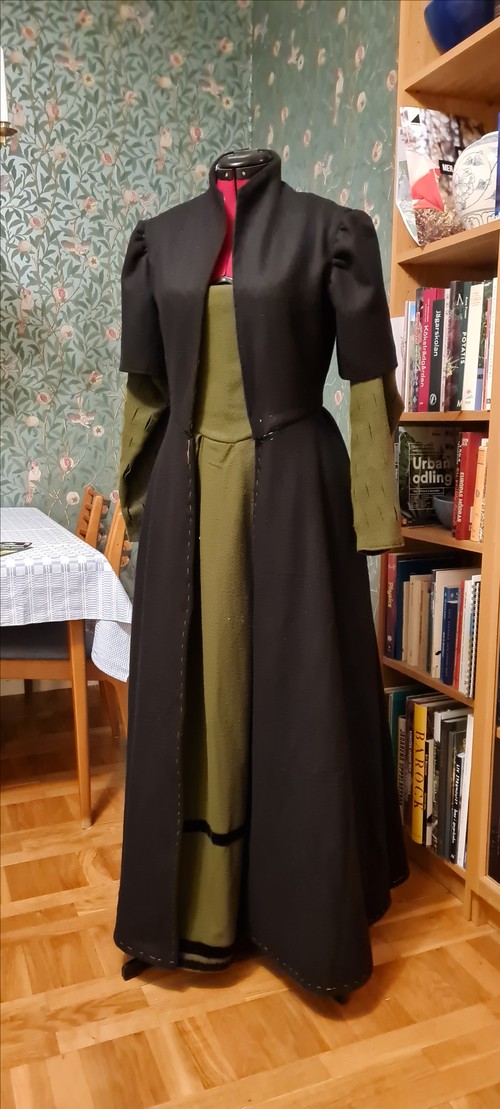Lots and lots of hemming. The running stitch catch both layers (as in, also the turned-under seam allowance) of the lining, the seam allowance of the top fabric and ideally, about half of the thickness of the top fabric, making a small indentation on the outside without too much of the bright linen thread showing.
All in all this was a rather straight forward project. I did all the sewing by hand, and opted for finishing both the sleeves and the armholes individually, then cartridge pleating the sleeves and whip-stitching them together. This means that some linen thread show, but it saves a lot of weird bulk around the armhole. Among other things*
The finished gown. Closed with hooks and eyes in front. Grown-on collars are another nemesis of mine, but I love them all the same and will not give up trying.
I wore it for a brief part of an event in July (it's Sweden, after all, a warm outer garment is not a bad thing most nights), re-did a bit of the hem and then wore it again to an event in October. This time I actually got pictures:
A rather sucessfull attempt at a Lucas de Heere look if I may say so myself. Worn here with the brocade kirtle and the green sleeves. From a historical accuracy perspective, please ignore the sad lack of Proper and Decent headwear - it was a larp, after all. Photo: Sandra Hjelmerus
The finished outfit (shift, petticoat, kirtle, sleeves, gown) weighs in at nearly six kilos. Not uncomfortable to wear, but next time I wear it to run up and down stairs and dance for an evening, I will make a mental note to self to undress a bit slower when changing back into modern gear, so that I will not have a suprise sit-down on the floor. Rookie mistake!
The facts:
The challenge: 2023:1, Back to the beginning
What the item is: a fitted English gown
How it fits the challenge: it is the final touch to my very first Tudor project
Material: Wool, linen
Pattern: from the Tudor Tailor
Year: 16th century
Notions: Waxed linen thread, a bit of black silk thread for the finishing of the sleeves iirc.
How historically accurate is it? I say about 90%. Good pattern, good materials, hand-sewn. Some deviations in construction and I am not sure that the top fabric would be exactly the right quality. It's supposed to mimic broadcloth and I think it does a decent job.
Hours to complete: 40-50, with hand-sewing and later alterations.
First worn: July 2023
Total cost: No idea, really. I bought the fabric more than ten years ago and didn't keep the paperwork. If I were to buy ut today I guess I would have to pay about 70-90 euros for the top fabric, plus another 30ish for the lining, so I'll make a stab at somewhere around 75 euros, but more like 120 in today's money.
*Other things being that despite how nice the bodice fit looked, it seems I have about ten extra centimeters in circumference just around the armhole which pulls a bit weirdly, so at some point I will probably want to remove at least the lower half of the sleeve, take the bodice in and re-attach. I guess this will actually be easier with the parts made separate to start with. Alas, it's a project for another day...














